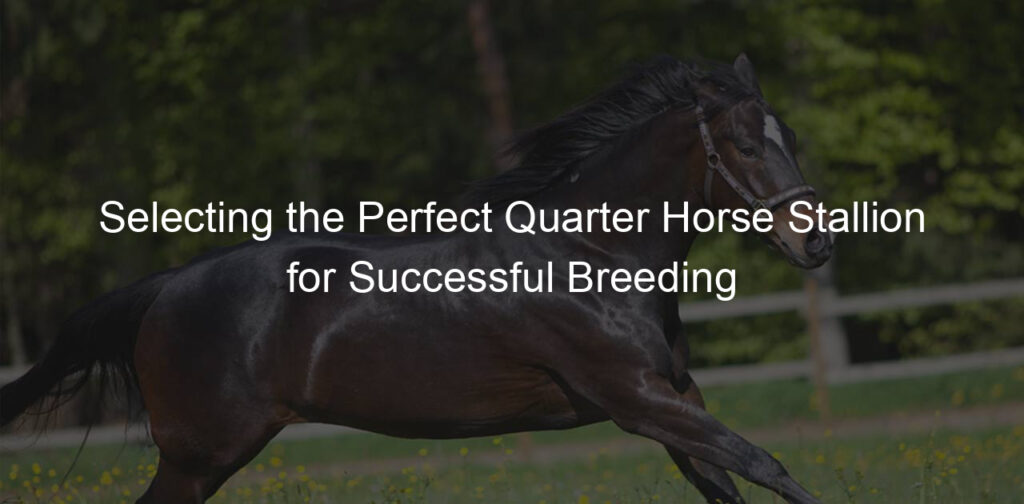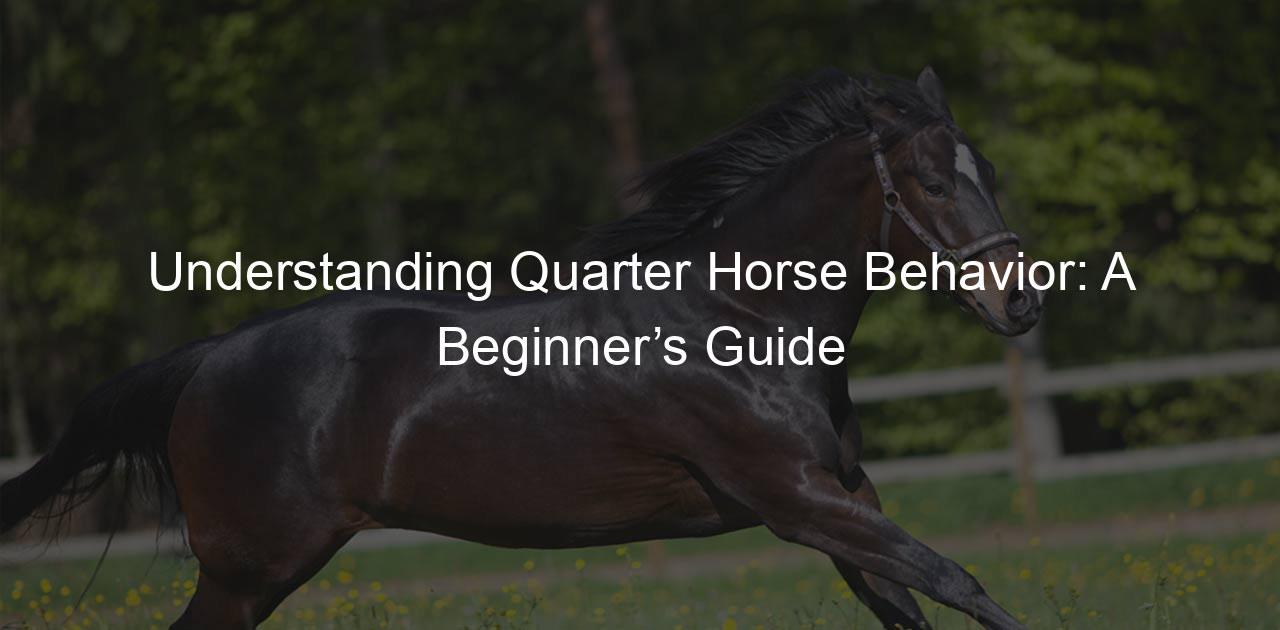Introduction to Quarter Horse Breeding
Welcome to the exciting world of Quarter Horse breeding! If you’re a horse lover, you’ll find this topic fascinating. Let’s dive in and learn about the basics of horse breeding and the importance of choosing the right stallion.
- Understanding the basics of horse breeding
Before we get into the specifics of Quarter Horse breeding, it’s important to understand the basics of horse breeding in general. Breeding horses isn’t just about putting two horses together and hoping for the best. It involves a deep understanding of horse genetics, health, and behavior.
Did you know that horses have a gestation period of about 11 months? That’s almost a year! And after the foal is born, it takes another few years for it to mature into an adult horse. So, breeding horses is a long-term commitment.
But don’t worry, it’s not all hard work. Breeding horses can also be incredibly rewarding. There’s nothing quite like seeing a newborn foal take its first steps, or watching a young horse grow up to become a champion racer or a trusted workhorse.
- The importance of choosing the right stallion
When it comes to breeding Quarter Horses, choosing the right stallion is crucial. The stallion contributes half of the genetic material to the foal, so his traits can have a big impact on the foal’s abilities and temperament.
But it’s not just about genetics. The stallion’s health and behavior are also important. A healthy stallion is more likely to produce healthy foals. And a well-behaved stallion is easier to handle during the breeding process.
So how do you choose the right stallion? It’s all about research. Learn as much as you can about the stallion’s pedigree, performance history, and health records. And don’t forget to consider his temperament. After all, you want a stallion that’s not only a good breeder, but also a good horse.
Stay tuned for more on this topic in our next section, “Choosing a Stallion: Key Factors to Consider”.
Choosing a Stallion: Key Factors to Consider
When it comes to selecting a Quarter Horse stallion, there are several key factors to consider. One of the most important is the physical characteristics of the horse. Let’s dive into what you should look for.
Quarter Horse Stallion Selection: Physical Characteristics
Physical traits are a big deal when choosing a stallion. They can tell you a lot about the horse’s health, strength, and potential for breeding. Here are the main physical characteristics to consider:
- Size and Build
- Color and Markings
- Health and Fitness
The size and build of a Quarter Horse stallion can give you a clue about his strength and endurance. Quarter Horses are known for their muscular build and compact size, typically standing between 14 and 16 hands high. A well-proportioned body with a broad chest and powerful hindquarters is ideal for both performance and breeding.
While color and markings don’t affect a horse’s abilities, they can be important for breeding purposes. Quarter Horses come in a variety of colors, from chestnut to black, palomino to gray, and everything in between. Some breeders may prefer certain colors or markings for aesthetic reasons or to continue a specific lineage.
Health and fitness are crucial when choosing a stallion. A healthy horse will have clear, bright eyes, a shiny coat, and a good appetite. He should be free from any signs of illness or injury. Fitness is also important. A fit horse will have a strong, muscular build without being overweight. Regular vet checks and a good diet and exercise regime are key to maintaining a stallion’s health and fitness.
Remember, choosing a stallion is a big decision that should not be taken lightly. Take your time, do your research, and consult with experts if needed. After all, the right stallion can make all the difference in your breeding program.
Quarter Horse Stallion Selection: Temperality
When choosing a Quarter Horse stallion for breeding, it’s not just about how the horse looks. The stallion’s temperament plays a significant role too. Let’s dive into the two main aspects of temperament: behavior and attitude, and trainability and intelligence.
- Behavior and Attitude
- Trainability and Intelligence
Behavior and attitude can tell you a lot about a horse. A stallion with a calm and friendly demeanor is often easier to handle and train. It’s important to observe how the horse interacts with people and other horses. Does he seem aggressive or nervous? Or is he relaxed and confident? Remember, a horse’s behavior and attitude can influence the temperament of its offspring. So, choosing a stallion with a good attitude can lead to a new generation of well-behaved Quarter Horses.
Another key factor to consider is the stallion’s trainability and intelligence. Quarter Horses are known for their quick learning and adaptability. A smart stallion that’s easy to train can pass these traits to its foals. You can gauge a horse’s intelligence and trainability by observing how quickly it learns new tasks or adapts to new environments. A horse that’s eager to learn and responds well to training is a good choice for breeding.
Remember, a stallion’s temperament is just as important as its physical characteristics and pedigree. A horse with a good temperament can make the breeding process smoother and result in offspring that are a joy to raise and train.
Quarter Horse Stallion Selection: Pedigree
When choosing a Quarter Horse stallion, the pedigree is a crucial factor to consider. The pedigree of a horse is like its family tree. It tells us about its ancestors and their achievements. Let’s dive into this topic a bit more.
- Lineage and Ancestry
- Performance and Achievements of Ancestors
The lineage of a Quarter Horse stallion can tell us a lot about its potential. It’s like looking at a family history. If the stallion comes from a line of successful racehorses, it’s likely that it will also be a good racer. For example, the famous Quarter Horse stallion, Impressive, had a lineage of top-notch show horses. This lineage played a big part in his success.
The performance and achievements of a stallion’s ancestors are also important. If a stallion’s parents or grandparents were champions, it’s a good sign. It means they had the right genes for success. For instance, the legendary Quarter Horse, Doc Bar, had ancestors who were renowned for their performance in cutting horse competitions. This pedigree helped Doc Bar become one of the most influential sires in the Quarter Horse breed.
Remember, a good pedigree doesn’t guarantee success, but it can increase the chances. So, when you’re choosing a Quarter Horse stallion, don’t forget to check out its family tree!
Breeding Quarter Horses: Understanding Genetics
When it comes to breeding Quarter Horses, understanding genetics is a key part of the process. Let’s dive into the fascinating world of horse genetics and see how it affects our beloved Quarter Horses.
- Basic principles of horse genetics
- Common genetic disorders in Quarter Horses
- The role of genetics in breeding quality Quarter Horses
Just like humans, horses inherit genes from their parents. These genes determine everything from their color to their height and even their behavior. Each horse has two sets of chromosomes, one from each parent. The combination of these chromosomes determines the horse’s genetic makeup. Learn more about horse genetics here.
Unfortunately, some Quarter Horses are prone to certain genetic disorders. One of the most common is HYPP (Hyperkalemic Periodic Paralysis), which affects the horse’s muscle control. Another is HERDA (Hereditary Equine Regional Dermal Asthenia), a skin condition. It’s important to test potential breeding horses for these disorders to ensure the health of the offspring. Find out more about these disorders here.
Genetics plays a huge role in breeding quality Quarter Horses. By understanding a horse’s genetic makeup, breeders can predict certain traits in the offspring. This can help breed horses with desirable traits like speed, strength, and a calm temperament. However, it’s also important to remember that environment and training also play a big role in a horse’s development. Learn more about the role of genetics in horse breeding here.
Understanding genetics can seem complicated, but it’s a crucial part of breeding healthy and successful Quarter Horses. By taking the time to learn about horse genetics, you can make informed decisions and help ensure the future health and success of the breed.
Stallion Breeding Guide: The Breeding Process
Hey there, horse lovers! Let’s dive into the exciting world of stallion breeding. It’s not just about picking the prettiest horse in the field; there’s a lot to consider. So, let’s get started!
Preparing Your Stallion for Breeding
Before we get to the actual breeding process, we need to make sure our stallion is in tip-top shape. Here are a couple of things you need to do:
- Health Checks and Vaccinations
- Diet and Exercise
First things first, your stallion needs to be healthy. Regular health checks are a must. Your vet will check for any diseases that could affect the breeding process. Also, make sure your stallion is up-to-date with all his vaccinations. This will protect him and the mare from any potential health risks.
Just like us, horses need a balanced diet and regular exercise to stay healthy. Make sure your stallion is getting all the nutrients he needs, especially during breeding season. Exercise is also crucial. It helps keep your stallion fit and reduces stress, which can affect his ability to breed.
Remember, a healthy stallion is more likely to produce healthy offspring. So, take the time to prepare your stallion for breeding. It’s worth it!
The Breeding Process: Natural Cover vs. Artificial Insemination
When it comes to breeding Quarter Horses, there are two main methods to consider: Natural Cover and Artificial Insemination. Both have their advantages and disadvantages, and the best choice depends on your stallion and your specific situation.
- Pros and Cons of Each Method
- Choosing the Best Method for Your Stallion
Let’s start with Natural Cover. This is the traditional method where the stallion and mare mate naturally. It’s simple and doesn’t require any special equipment. However, it can be risky as there’s a chance of injury to both horses. Plus, the stallion can only cover a limited number of mares in a season.
On the other hand, Artificial Insemination is a more modern method. It involves collecting semen from the stallion and artificially inseminating the mare. This method is safer for both horses and allows the stallion to breed with more mares. However, it’s more complex and requires professional assistance. Plus, not all horse registries accept foals produced this way. You can learn more about it on Wikipedia.
So, which method is best for your stallion? Well, it depends on a few factors. If your stallion is young, healthy, and well-behaved, Natural Cover might be a good option. But if you want to minimize risk or breed with a large number of mares, Artificial Insemination could be the way to go.
Remember, every stallion is unique. What works for one might not work for another. So, take your time, do your research, and consult with a vet or a breeding expert before making a decision.
Whichever method you choose, remember that breeding is a big responsibility. It’s not just about producing foals, but about ensuring the health and well-being of your horses. So, make sure you’re prepared and committed before you start this exciting journey.
Case Study: Successful Quarter Horse Breeding
Let’s dive into a real-life example of successful Quarter Horse breeding. We’ll explore the background of the stallion and mare, the selection process, and the outcome of the breeding, along with the lessons we learned.
- Background of the stallion and mare
- Selection process
- Outcome and lessons learned
Our stallion, Thunder, is a handsome 5-year-old Quarter Horse with a strong pedigree. He’s known for his agility, speed, and friendly demeanor. The mare, Daisy, is a 6-year-old Quarter Horse with a gentle nature and excellent health. Both horses have a solid lineage of performance and show horses, making them ideal candidates for breeding.
The selection process was meticulous. We considered the horses’ health, age, temperament, and pedigree. We also consulted with a veterinarian and a professional horse breeder to ensure we were making the best decision. The goal was to breed a Quarter Horse that would excel in both performance and temperament.
The breeding was successful, resulting in a healthy foal named Lightning. Lightning has inherited his parents’ best traits, showing great potential as a future performance horse. The process taught us the importance of careful selection, professional advice, and patience. Breeding horses is not a quick process, but the reward of a healthy, strong foal is worth the wait.
We hope this case study gives you a clearer picture of what goes into successful Quarter Horse breeding. Remember, every horse is unique, and what works for one pair may not work for another. Always consult with professionals and do your research before embarking on your breeding journey.
Conclusion: The Reward of Breeding Quality Quarter Horses
As we wrap up our discussion on Quarter Horse breeding, it’s essential to highlight the rewards that come with breeding quality Quarter Horses. It’s not just about producing a horse; it’s about contributing to the breed’s legacy and improving its quality. Let’s take a closer look at the benefits of careful stallion selection and the impact on the Quarter Horse breed.
- Benefits of Careful Stallion Selection
- Improved Offspring Quality: A quality stallion can pass on desirable traits to its offspring, resulting in healthier, stronger, and more athletic horses.
- Preservation of Breed Characteristics: Stallions that embody the best characteristics of the Quarter Horse breed help preserve these traits for future generations.
- Increased Value: Offspring from a well-chosen stallion often have a higher market value, making them a good investment.
- Impact on the Quarter Horse Breed
- Preservation of the Breed: By selecting top-quality stallions and mares, breeders can help maintain the unique characteristics that make Quarter Horses so special.
- Improvement of the Breed: Each new generation of horses is an opportunity to improve the breed. By focusing on health, temperament, and athletic ability, breeders can enhance the overall quality of the Quarter Horse breed.
- Contribution to the Horse Community: Quality Quarter Horses are in high demand for various equestrian activities. By breeding quality horses, you’re contributing to the equestrian community and helping to meet this demand.
Choosing the right stallion is a crucial step in the breeding process. A carefully selected stallion can bring numerous benefits, including:
Quality breeding practices have a significant impact on the Quarter Horse breed as a whole. Here’s how:
In conclusion, breeding quality Quarter Horses is a rewarding endeavor that benefits not only the individual breeder but also the entire Quarter Horse breed and the equestrian community. It’s a labor of love that requires knowledge, patience, and a deep appreciation for these magnificent animals.









